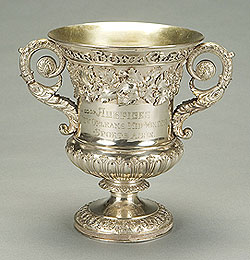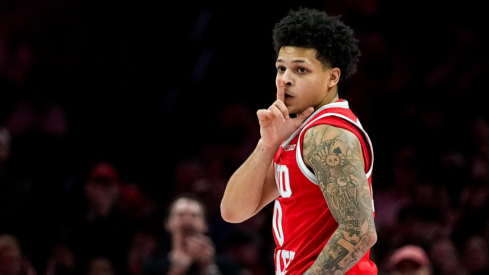
The Ohio State football program is all about tradition and its rich history. A tradition the Buckeyes have upheld for years is playing in some of the most hallowed bowls; the Rose, Orange, Fiesta and, for the fifth* time come Jan. 4, the Sugar Bowl.
Played annually since 1935, the Sugar Bowl (along with the Orange and Sun) is the second-oldest bowl game in the country. Last season's contest marked the game's 75th anniversary.
Like everything in college football (at least it seems that way), the game was the idea of a prominent newspaperman and sports editor in New Orleans. After eight years of wrangling there was finally enough support for the creation of the Sugar Bowl. For the first 40 years, the game was played outdoors at Tulane Stadium until the Louisiana Superdome was built.
After Hurricane Katrina devastated New Orleans and much of the Gulf Coast, it became apparent the Superdome would not be able to host the 2006 edition of the Sugar Bowl. The Georgia Dome stepped in and played host. The Superdome took over its hosting duties the next season and has hosted the game every year since.
Unlike most bowl games that recycle their way through sponsors, the Sugar Bowl has only had three sponsors in its history. USF&G was the title sponsor from 1987-1995 before Nokia took over for a a dozen years. In 2007, Allstate began its run as sponsor. Until Fox took over the broadcasting rights of the BCS games, ABC had aired the Sugar Bowl 28 consecutive years. The game will go back to its roots this season as ESPN (which is owned by Disney which also owns ABC) begins broadcasting the BCS games.
Like the Rose Bowl's contractual agreement with the Big Ten and Pac-10, the SEC has long been associated with the Sugar Bowl. Including this season, the past 11 games have featured an SEC team. 2000 was the last time an SEC team didn't appear in the game and the only reason one didn't that year was because the Sugar Bowl hosted the national championship game. Alabama and LSU have appeared in the most Sugar Bowls at 13 a piece. 'Bama has won the most games, garnering an 8-5 record.
The Buckeyes first appeared in the Sugar Bowl following the 1977 season. The 9-3 and eighth-ranked Buckeyes faced No. 3 (11-1) Alabama. It was actually a surprise that the two teams were matched up. Notre Dame also had one loss and many thought an Irish-Crimson Tide show down was too good to pass up. The Sugar Bowl had other ideas, though, and felt matching Bear Bryant and Woody Hayes against one-another was a golden opportunity. It also marked the first time a Big Ten school had played in the Sugar Bowl.
Ohio State and Alabama had two of the best offenses and defenses in the country that season. You certainly would have believed it watching 'Bama, but not the Buckeyes (not the offense anyway). The Crimson Tide racked up almost 400 yards of offense and 25 first downs en route to a 35-6 shellacking of the Buckeyes. The score was 20-0 before Ohio State even put points on the board. The 'Bama defense pressured Rod Gerald into three interceptions. Amazingly, Alabama fumbled the ball 10 times, but only two were recovered by Ohio State.
It would be another 20 years before Ohio State would return to New Orleans. When they did, they faced one of the best teams in the country again - Florida State. The match-up between the No. 4 Seminoles and No. 9 Buckeyes was highly anticipated. Unfortunately, for Ohio State it was over in a hurry.
The Buckeyes took a 3-0 lead before Florida State rattled off 21 unanswered points to take a 21-3 lead into the locker room at halftime. The Buckeyes wold pull to within 13 (21-8) and 10 (24-14), but that was the closest they got, eventually losing 31-14. It was an unusual 14 points scored by OSU. Two field goals, a safety and a touchdown with a failed two-point conversion.
The game turned on Ohio State while they trailed 7-3. Prior to the game, John Cooper spoke with the officials about a fake field goal they were going to run during the game. The officials said the play was legal and that they'd watch for it. Ohio State ran the play to perfection as holder Brent Bartholomew threw a strike to John Lumpkin for a touchdown. However, Lumpkin was flagged for not reporting to the huddle. Cooper and the OSU coaches were furious at the officials. Ohio State would end up missing a field goal on the possession and the flood gates opened from there.
Ohio State actually had more first downs than Florida State and held the Seminoles to 60 rushing yards. Thad Busby went wild, though, with 334 passing yards. Jan. 1, 1998 was one of the worst days ever for Buckeye fans. Not only did Ohio State get blown out, but Michigan defeated Washington State in the Rose Bowl prior to the Sugar Bowl to win the national title.
The Buckeyes returned to New Orleans the next year to take on a Texas A&M team that had knocked off No. 1 Kansas State a few weeks earlier. The Buckeyes were arguably the best team in the country that season, but a November loss to Michigan State derailed their title hopes. That is, until Dec. 5, 1998 came around. No. 1 Kansas State and No. 3 UCLA both lost. If No. 2 Tennessee lost, the Buckeyes would find themselves back in the title game. Unfortunately, they recovered in the second half of the SEC Championship Game against Mississippi State to win the game.
Heading into the game, some believed if Ohio State won impressively and Florida State beat Tennessee in a sloppy Fiesta Bowl, the Buckeyes could be crowned national champions. Ohio State dismantled A&M, winning 24-14, but it could have been much worse. After trailing 7-0, the Buckeyes rattled off 24 straight points to take a 24-7 lead at the half. However, they got complacent in the second half and failed to score.
Ohio State outgained A&M 432-283. After the Aggies had run all over Kansas State in the Big XII title game, OSU limited them to 96 yards on the ground. Joe Germaine threw for 222 yards and a touchdown. Joe Montgomery and Michael Wiley combined for 184 yards rushing and a touchdown.
*Technically Ohio State has only been to three Sugar Bowls, but I am lumping the 2008 BCS National Championship Game with the rest. While it wasn't the Sugar Bowl, it was still played in the Superdome and every other aspect of the game was the same as the Sugar Bowl.
While the crazy ending to the 1998 season didn't work out for Ohio State, the tailspin of every Top 10 team in the country in 2007 worked out A-OK for the Buckeyes. Like 1998, a November loss appeared to end all national championship aspirations Ohio State had. Then all hell broke loose. Countless teams in the Top 5 lost, including No. 1 and No. 2 (Thanks Rich Rod!) on the last day of the season. Thus, one-loss Ohio State and two-loss LSU squared off with a national title on the line.
Despite a total meltdown the previous year vs. Florida in the championship game, Ohio State and its fans were extremely confident entering the game. And why not? LSU had already lost twice. In eerily similar fashion to the 2007 title game, OSU jumped out to a quick 10-0 lead before the apocalypse arrived again. LSU rattled off 31 straight points to take a 31-10 lead. The Buckeyes cut the lead to 14 and had the ball, but Todd Boeckman and a porous offensive line spelled doom for Ohio State. LSU won the game 38-17 to captures it second national championship in five years.
Fun trip down memory lane, huh? Ohio State is 1-3 in the Superdome and all three loses were routs. We're told history doesn't matter. But does it? Some parallels and statistics are too hard to ignore. For example, the Buckeyes 0-9 record against SEC teams in bowl games. Nine games is a pretty big sample. It can't just be a coincidence that OSU has lost every time they faced a team from the Southeastern Conference in the post season, can it? New Orleans is the city of Voodoo. Maybe someone can cast a spell on Arkansas and deliver a much needed victory to Ohio State. On second thought, that probably won't be needed. After all, Ryan Mallett is a Michigan Man.

